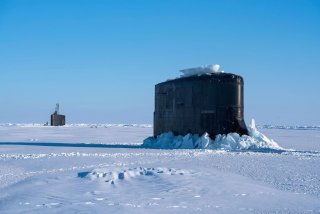Why Has Russia’s Northern Fleet Returned to the Arctic?
The Northern Fleet announced that it will be hosting a new wave of drills this autumn.
Here's What You Need To Remember: The Northern Sea Route provides commercial ships in the Saint Petersburg area with a greatly expedited form of transit to East Asia through the Bering Sea.
The Onega and Naryan-Mar Grisha III- class corvettes launched torpedo attacks against a notional enemy’s submarine in the White Sea, according to the Northern Fleet’s press office. The Typhoon-class submarine Dmitry Donskoi played the role of the enemy vessel, the Northern Fleet specified. "The warships searched for the submarine using onboard sonars and launched a torpedo attack against it. The heavy nuclear-powered underwater cruiser Dmitry Donskoi operating at a depth of over 100 meters simulated the underwater enemy for the small anti-submarine warfare ships," read the press statement. The dummy torpedoes fired against Dmitry Donskoi were recovered and brought back to base following the exercises. The drills were staged out of the Northern Fleet’s Belomorskaya naval base, located in the Arkhangelsk region of northwestern Russia. The Northern Fleet is headquartered in the Murmansk region’s town of Severomorsk, not far off Russia’s state border with Finland.
The Grisha III class is a line of Soviet-built, dedicated anti-submarine corvettes, six of which are currently active in Russia’s Northern Fleet. The ships boast two RBU-6000 anti-submarine rocket launchers, carrying a total of ninety-six rockets, as well as two standard 533 torpedo tubes and a 9K33 “Osa” surface-to-air missile launcher. The Grisha class has been succeeded by the Steregushchiy corvette class, which is not specifically an anti-submarine vessel but offers a versatile enough armament loadout to serve in that role. The Paket-E/NK system of the latter provides what is an overall more effective solution against submarines, boasting anti-submarine MTT torpedoes with an operational range of up to 10,000 meters. Onega and Naryan-Mar are part of a naval task force that conducted artillery fire exercises against sea and air targets, as well as anti-submarine operations. It is unclear what other ships were included in this task force and how long this ongoing set of exercises will run.
Dmitri Donskoi is the sole remaining Typhoon-class nuclear-powered heavy ballistic missile submarine (SSBN). Laid down in 1976, it held—and by some measures, still retains—the title of the largest military submarine ever built. The Typhoon-class is being replaced by the newer and more capable Borei-class SSBNs, with Donskoi reportedly scheduled to serve through the mid-2020s.
These exercises follow a series of Russian bomber drills conducted earlier this month, which involved Tu-160 and Tu-95MS planes launching cruise missiles during a live-fire session at an Arctic firing range. The Northern Fleet announced that it will be hosting a new wave of drills this autumn, nominally aimed at protecting Russia’s Northern Sea Route. The route provides commercial ships in the Saint Petersburg area with a greatly expedited form of transit to East Asia through the Bering Sea.
Moscow has recommitted to ramping up its Arctic military activity in recent months, with Deputy Chairman of the Security Council Dmitry Medvedev saying during an earlier session of Russia’s Arctic Commission that Russia “must continue its work on the strengthening of Arctic troops equipped with modern types of armament.”
Mark Episkopos is a national security reporter for The National Interest.
This piece first appeared earlier this year and is being reprinted due to reader interest.
Image: Wikimedia Commons.

